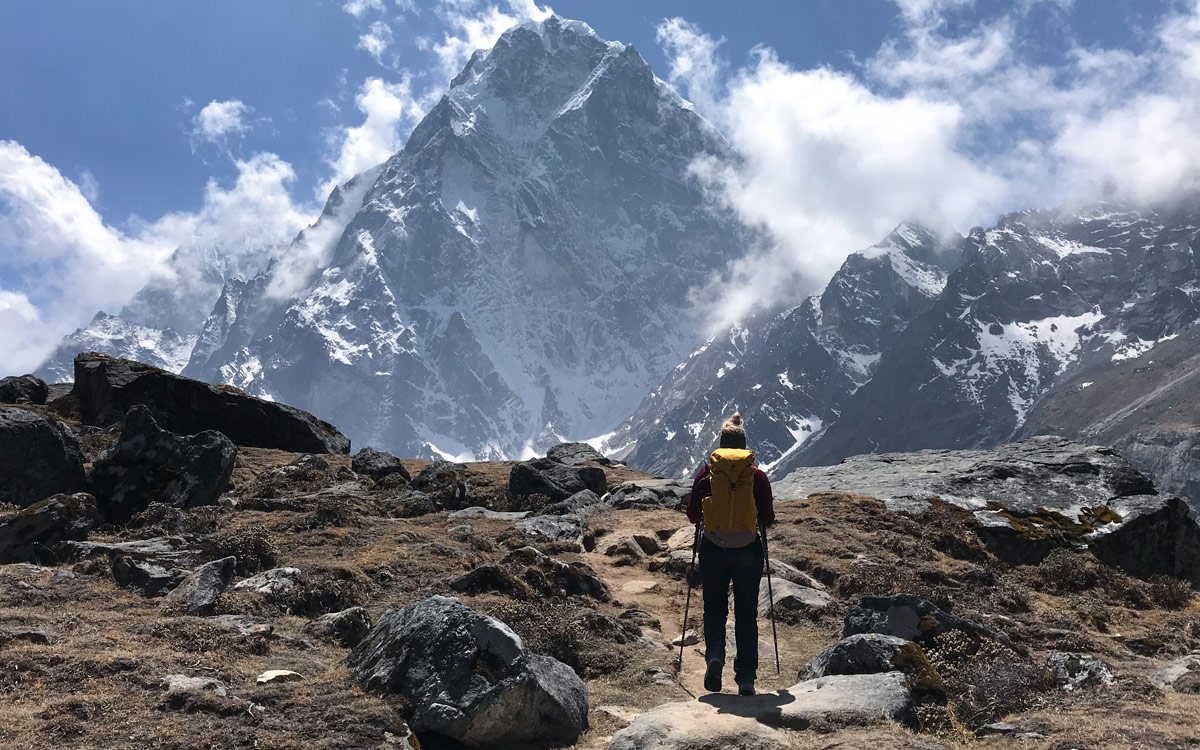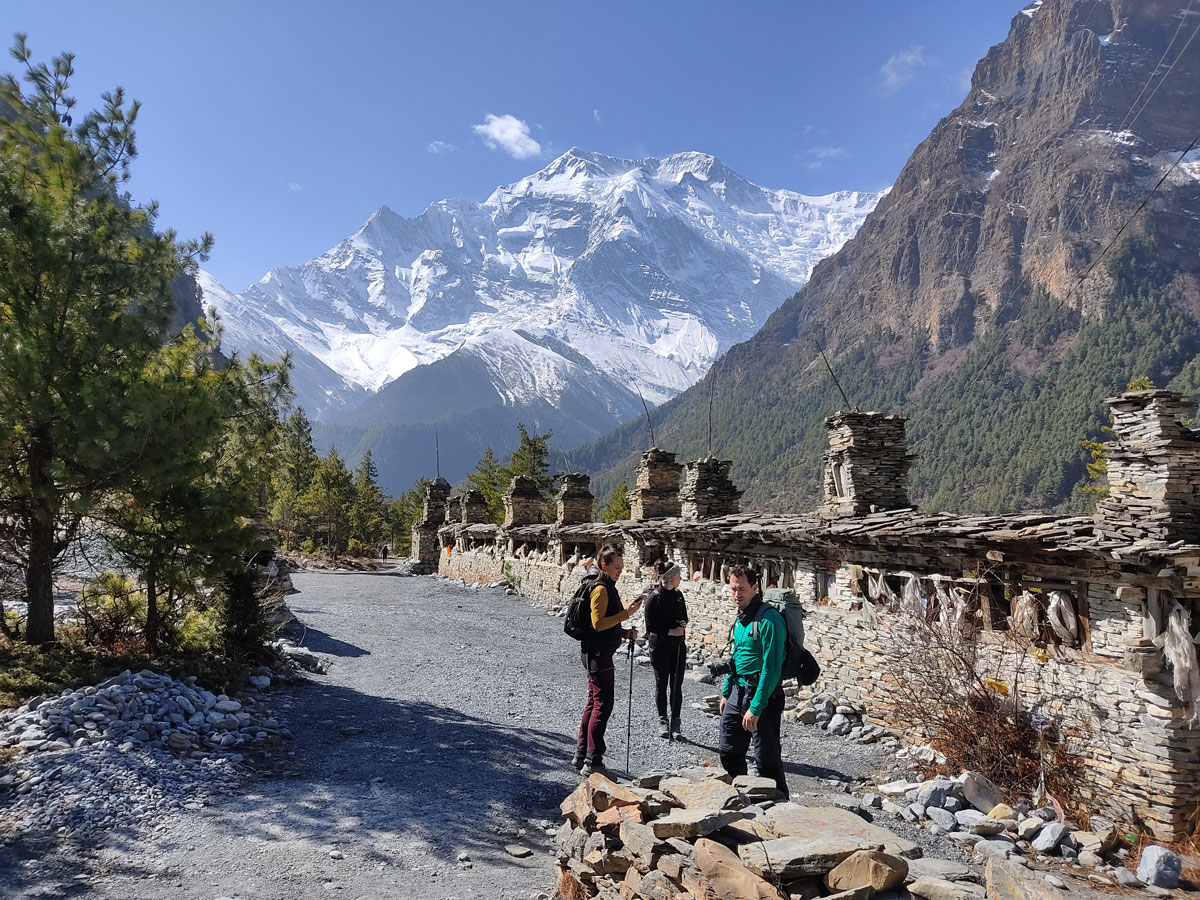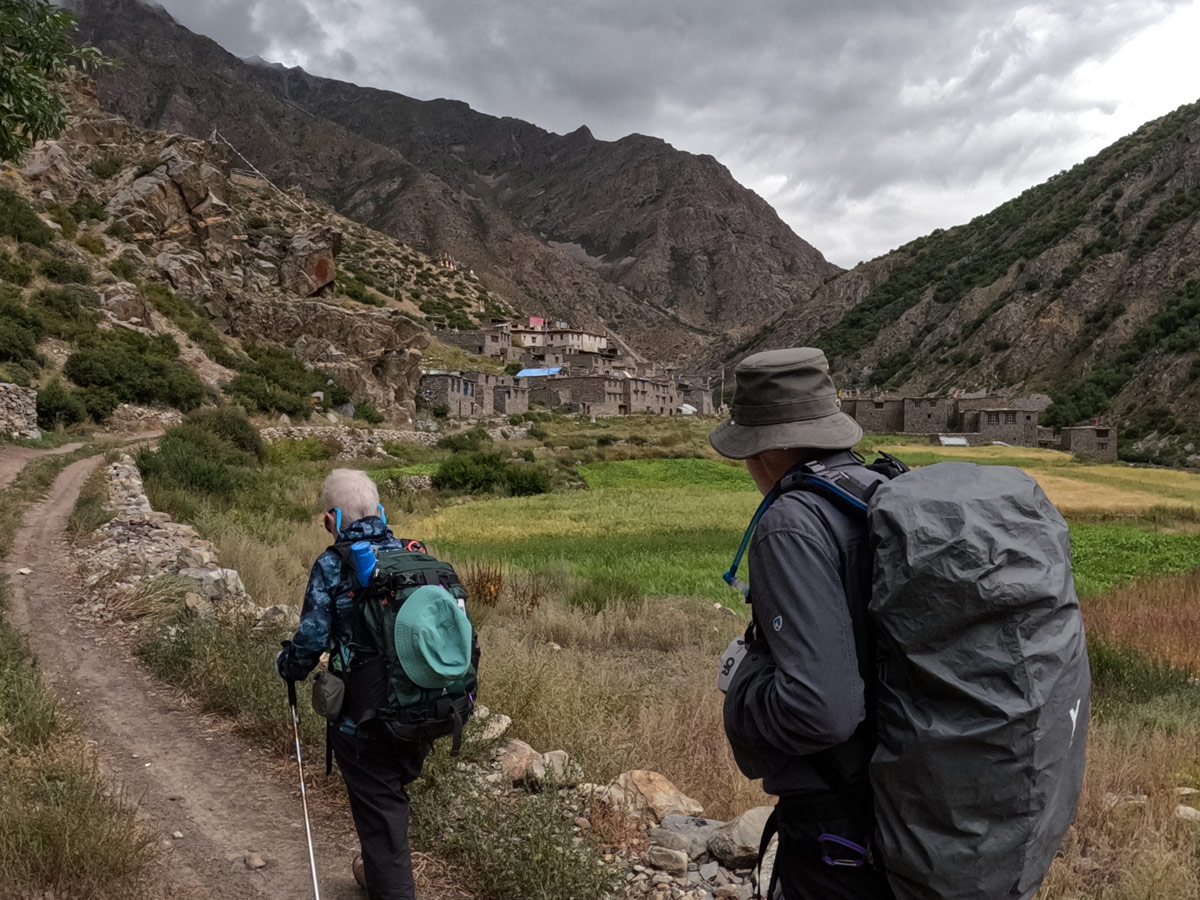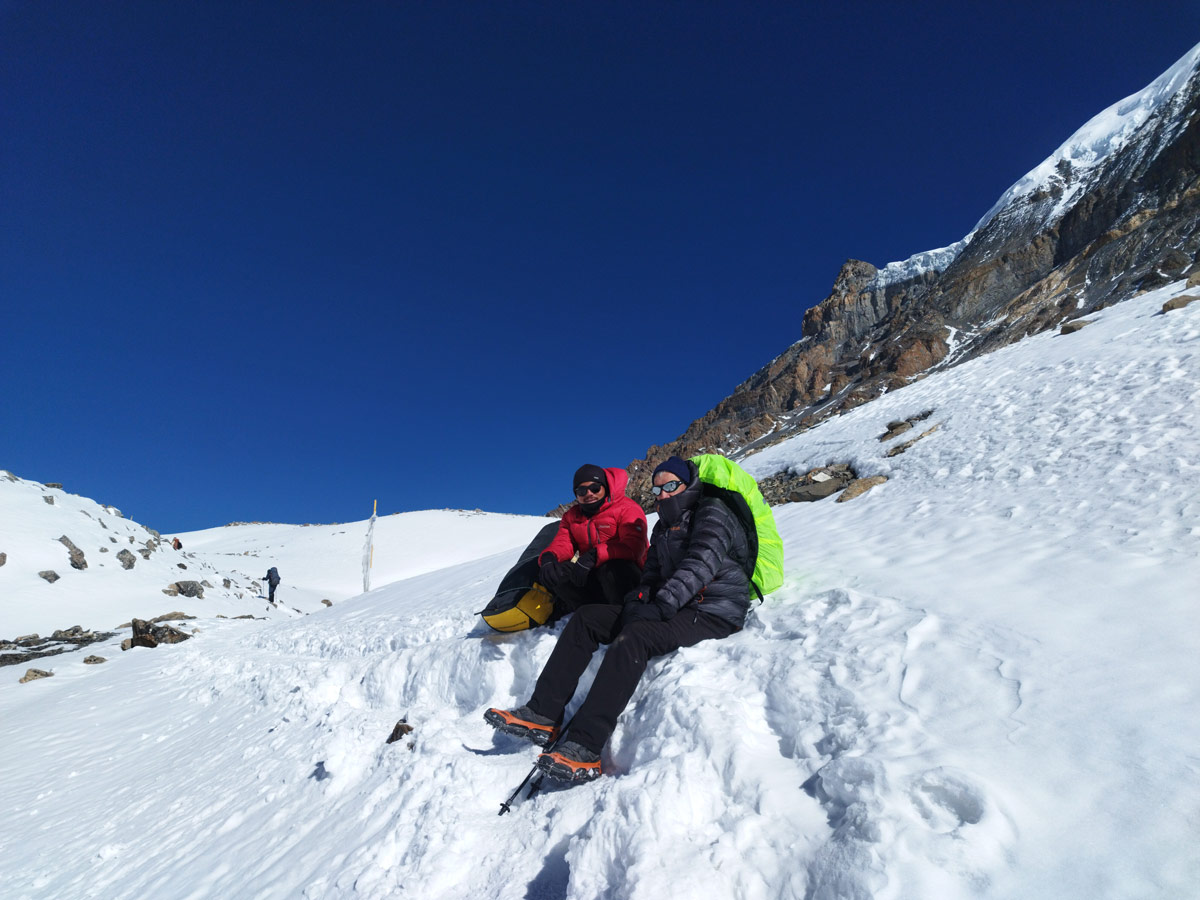Trekking in Nepal is an affair like no other, it is a package of fresh expeditions that bring you away and push you close to the world both at the same time.
Treks in Nepal are distinguished by its offerings of natural beauty, cultural perpetuity, and diversity.
Home to the world’s tallest mountain Mount Everest and eight of the fourteen highest summits in the world, trekking in Nepal itself is a peak many wish to conquer.
Treks here are uniquely diverse, from long-term expeditions deep into the Himalayas challenging one’s resolve to short treks that readily capture hearts.
Catering not just to nature lovers that rejoice in the beauty of the natural but trekkers that value history, community and culture, your adventure in Nepal will serve you through all kinds of earthly experiences.
Why trek in Nepal?
In essence there shouldn’t be much of a difference between treks in Nepal and elsewhere, so what is the extraordinary factor that fuels the popularity of the trekking scene here and sets it apart?
The following are a few reasons why you should trek in Nepal:
Variety
From easy treks low in altitude and difficulty to treks that challenge and prod, Nepal has it all.
For beginners who are yet to climb significant altitudes, Nepal has several hikes even below 4,000m to help you adjust and enjoy.
Ghandruk Trek (1,950m), Panchase Trek (2,500m), and Ghorepani Poonhill trek (2,860m) are reasonably one of the best walks in the country.
Likewise, if you love yourself a challenge and thirst for several nights in solitude alongside views and experiences that make you feel anew, Nepal also offers numerous treks that open its wilderness to explore.
Everest Base Camp Trek , Annapurna Circuit Trek reaching its highest point at Thorung La Pass (5,416m), Everest Three Passes Trek combining three high passes of the Everest region, Kongma La (5,535 m), Cho La (5,368m) and Renjo La (5,430m), and Kanchenjunga Base Camp Trek (5,140m) could be a few options for the adventurer in you.
Spectacular Scenery
As home to the most scenic and unique landscapes, Nepal has mountains and hills that will peak your memories forever.
Away from the civils of the world, trekkers can find themselves in peace within a world that doesn’t feel like the one they often live in.
Nepal’s Himalayas that engulf the country in its grandeur are a sight for the eyes to see. The picturesque valleys, serene lakes, lush colorful forests make Nepalese landscapes incomparable to any other.
Culture and People
Trekking in Nepal allows trekkers to bask in its diverse but warm culture.
As a country that shelters people of various ethnicities, practices and formalities, Nepal is a nation that remains one but varying in its beliefs.
Trekkers can experience first-hand traditions that have been followed ever since the Nepalese community first prospered.
Through wild trails and remote valleys, with the people and culture you encounter and explore, even the hardest of treks are so worth it.
Affordability
Nepal is known for budget travels, the country humble with its finances but excellent in its offerings.
For trekkers who are travelling tight but still don’t want to compromise with quality experience, trekking in Nepal is the answer.
Biodiversity
Nepal sits on the 49th position in the world biodiversity record. It is home to one of the most varied species of flora and fauna.
Its diverse ecosystem shelters wildlife you wouldn’t find anywhere else. There are over 22,000 species reported in Nepal which amounts to a total of 1.3% of the global biodiversity average.
For nature enthusiasts, trekking in Nepal can be a once in a lifetime opportunity to spot rare and endangered species and personally learn more about them.
Teahouse Trekking
In many trekking trails across the country, you can find various tea houses and lodges ready to accommodate and ease your tours.
The tea houses are convenient and easily accessible. This lodging experience makes it easy for trekkers to rest and recharge comfortably through the trails.
Solo Vs Guided treks in Nepal
Guided and solo treks are two exceptionally different trek options, both carrying a fair share of pros and cons.
Solo treks promise freedom and the bliss of spontaneity while guided treks ease through forethought, safety and companionship.
When it comes to choosing the best option for you, your preferences, your ability to adapt and control, alongside a thorough study of the destination, its provisions and record of conduct is significant.
In the context of Nepal starting April 1, 2023, solo treks were banned, trekkers visiting the country now are to compulsorily hire a licensed guide or porter for their treks through Nepal’s Conservation areas and National Parks.
The following table compares Solo and Guided Trek features to help you better understand and accordingly decide what could be a fitting option for you:
| Features | Solo Trekking | Guided Trekking |
| Independence | Full control over itinerary and pace | Less control and responsibility |
| Flexibility | Plans can change according to preference | Sticking to the itinerary is mandatory |
| Safety | Completely self-reliant, handle emergencies alone | Guided by professional guides that will assist at all times |
| Cost | Cost effective (no guide fees) | Cost higher due to guide and group fees |
| Navigation | Can only rely on maps | Learned guides will actively assist through trails under their expertise |
Choosing the right season to trek in Nepal
Nepal offers one of the most inviting escapades to the wild and intimate, from views that boast the unseen to trails that challenge and charm, each of these recourses prove the best when the seasons are studied right.
Considering your preferences and abilities ensures satisfaction while weighing all options and circumstances helps prepare and protect yourself before you embark on your journey.
Further we will discuss weather settings in different seasons of Nepal:
Spring
Spring is one of the most popular seasons for trekking in Nepal. The months that fall under the season are March, April and May.
During the spring season, the trekking trails are lush and colored, it is also the season for Rhododendrons, their beauty adds even more to the already inviting treks.
The weather is warm and stable with clear skies, high altitude treks can be safely pursued around this time.
Trekkers can expect splendid views through their trails and up the ascended mountains, picturesque landscapes of the mighty Himalayas are definitely a sight to see.
Autumn
The months that fall under Autumn are September, October and November. As another excellent trekking season in Nepal, Autumn pulls a tremendous number of trekkers every year.
Since it’s the popular season tea houses and lodges are often crowded around this time.
Autumn is the perfect season for high altitude treks. The clear air and mild temperature ease trekkers through challenging walks. The trails are dry, clear skies and excellent visibility make it even better of an experience for them.
Winter
Winter is the coldest season falling in the months of December, January and February.
At higher altitudes, the weather can be quite harsh and extremely cold; heavy snowfall is apparent. Given these conditions Winter isn’t the most popular when it comes to trekking.
The lower altitudes may have mild, sunny days, but as you go higher up the circumstances aren’t even close to feasible. Many high passes are blocked by snow so getting around can be evidently taxing.
Trekking during this time is possible in some areas but proper gear, and preparation is essential.
Monsoon/ Summer
Monsoon season in Nepal brings heavy rainfall especially in the lowlands. Trekking during the monsoon months (June to August) is not highly preferred.
There could be chances of flooding, the trails can be muddy, and leech infested, making the trek uncomfortable and unsafe.
However, certain areas like the rainforests in Terai, and the upper Mustang area can still be explored.
How to choose the best trekking company?
Most of what your trek experience could result in depends on the company you choose to trust.
To ensure an adventure, safe and enjoyable it is important to take careful steps into deciding a travel partner.
A reliable trekking company ensures the best of your experience, you are protected and correctly guided, you will not need to worry about anything but making the most of your trip.
The following list will help you choose the best trekking company for yourself:
Determine your trekking goals
Before moving in to choose a trekking company, the first and the most significant step is deciding on your trekking destination. This will help narrow down your options.
Make sure to select destinations that fall under the trajectory of your planned duration, your trekking ability, and budget.
Research and Shortlist
Shortlist companies that specialize in the destination you have chosen for yourself. Make sure to take your time comparing your options and research to find the best.
Verify company registration and License
It is extremely important to confirm that the chosen company is officially registered and licensed by the country you are trekking to.
Treks can be challenging and often unpredictable, if a company is not registered or licensed, they might not be operating lawfully. Such companies could rush over various safety regulations, resulting in major mishaps.
Safety is not to gamble, ensuring the company’s authenticity will help avoid scams and secure quality.
Experience and reputation
The amount of experience a company has is directly proportional to the quality of trips they offer.
An experienced company will be able to provide you with better options, better routes, better deals and better guides.
You can quickly confirm the reputation and pace of a trekking company by gauging how travelers who have trekked with them assess their services and efficiency.
It is important to read through reviews and testimonials and contact personally if possible and required.
Guide certification
Guides are individuals you will be spending almost all of your trek with. They are equipped with vast knowledge, skills and trekking experience.
Before choosing a company, it is important to verify guide certification and their areas of expertise and experience. The quality of your trek will differ heavily in terms of your Guide and their professionalism.
Linking up with companies who provide certified guides ensures a wonderful trekking experience for you. Professional guides are well versed in minimizing risks, controlling the trek and always assisting trekkers.
Itinerary and services
Carefully study and compare the itineraries provided by different companies, choose a company that does your plans justice and best satisfies your wants.
It is important to ensure that the services provided by the company are up to your standards, from the accommodation provided and meal plans to transportation and permit provisions if required.
Pricing
Compare the prices of different companies and go for the one that seems the most reliable.
The key to choosing the best trekking company in terms of its pricing is to not be swayed by cheap prices but rather check whether the services provided by the company rightfully align with the prices they have set.
To thoroughly understand how the costs are set you could request a breakdown of the pricing, this will help you decide better.
Responsible Tourism
Choose a company that is responsible in its ways and free from records of malpractice and fraud. Make sure that the company respects local cultures and performs accordingly.
Sustainable tourism practices are especially talked of in the tourism scene today, companies that practice sustainable ways and actively promote environmental consciousness are always the better options.
Best Treks in Nepal
Trekking in Nepal offers a range of diverse options, from short and easy treks to challenging high-altitude adventures, catering to all those seeking either thrill or tranquility in the lap of nature.
With the fantastic geography of the country, you have an array of trekking routes to choose from. Perhaps, let me divert your interest in what makes Nepal the ultimate trekking heaven, by bringing you the best trekking routes in Nepal, that have captured the hearts of global adventurers.
Our list is solely based on the feedback of trekkers who have explored Nepal’s trekking routes and the popularity of these routes over time. So buckle up, and let’s take you on a journey through some of the best trekking in Nepal.
1. Everest Base Camp Trek in Nepal
| Max.Altitude: | 5,555 m/18,225 ft. |
| Trek Duration: | 14 days |
| Difficulty Level: | Strenuous |
| Best Months: | March, April, May, October, November, and until Mid-December |
| Trek Permits: | Sagarmatha National Park, TIMS |
| Accommodation Type: | Teahouse |
Highlights:
- Trek to the base of the world’s highest mountain, Mt.Everest
- Fly to the world’s most adventurous airport – Lukla
- Immerse in the serenity of the Sagarmatha National Park
- Experience the culture and tales of the ethnic Sherpa people
- Scenic views of the world’s highest mountains
Embarking on the journey towards the Everest Base Camp trek is an adventure that should be on every hiker and trekker’s bucket list.
While trekking in the Everest Region you’ll be immersed in the Sherpa culture at Namche Bazaar, the gateway to the world’s tallest mountain.
Then it takes you through the heart of the mountains, providing breathtaking views of towering peaks like Mt. Everest, Ama Dablam, Lhotse, Nuptse, Thamserku, Cho Oyu, and more.
The journey also presents the opportunity to visit the oldest and largest monastery in the region – Dingboche Monastery.
Trekking in Nepal is truly a one-of-a-kind experience that promises to leave you in awe of the majestic beauty of the Himalayas, and it’s something every adventurous traveler should experience at least once in their lifetime.
2. Everest High Passes Trekking
| Max.Altitude: | 5,555 m/18,225 ft. |
| Trek Duration: | 20 days |
| Difficulty Level: | Challenging |
| Best Months: | March, April, May, October, November, and until Mid-December |
| Trek Permits: | Sagarmatha National Park, TIMS |
| Accommodation Type: | Teahouse |
Highlights:
- Cross three beautiful high-elevation passes
- Witness remarkable views of Gokyo valley and Ngozumpa glacier
- Encounter Gokyo Lake’s turquoise waters
- Experience the remote hospitality of the region
- Catch a scenic mountain flight to/from Lukla
In case you’re looking for high-altitude trekking in Nepal with some challenging walking; Everest High Passes Trek is a once-in-a-lifetime experience that offers the perfect mixture of adventure and stunning natural beauty.
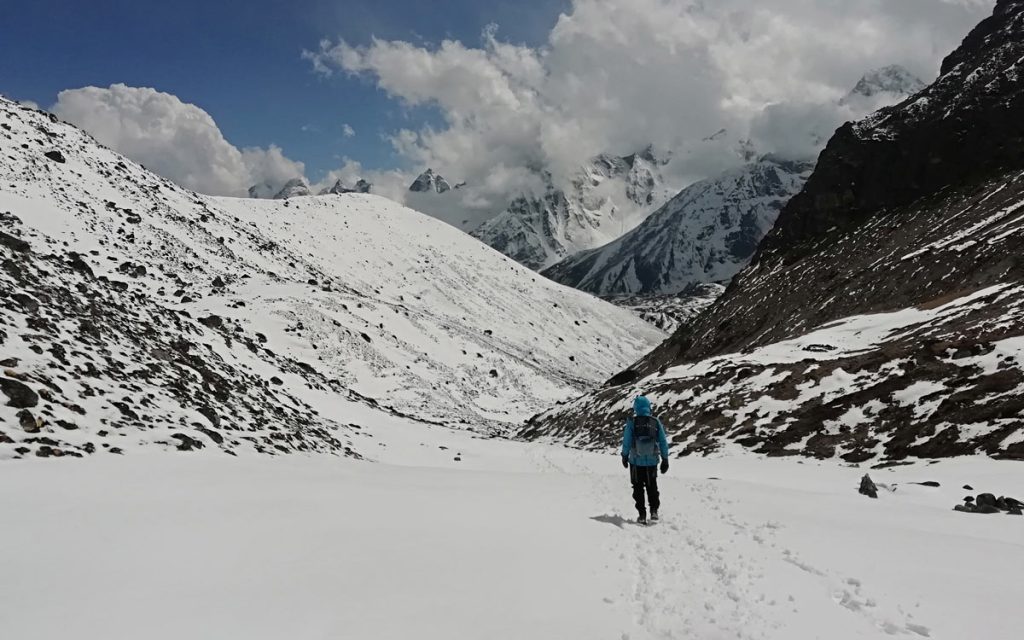
Trekking in between the Himalayas, you’ll witness some of the world’s tallest peaks and the largest glacier in Nepal, including some of the ancient monasteries of the region.
Additionally, the breathtaking views from the three high passes are sure to leave you spellbound, but it is also one of the most challenging high-altitude treks in Nepal.
The opportunity to explore the Beautiful Gokyo Valley and its pristine Lakes along with the Everest Base Camp at an altitude of 5,364 m, this trek is a must-do for anyone seeking an extraordinary and unique experience while trekking in Nepal.
3. Gokyo Lake and Everest Base Camp trek
| Max.Altitude: | 5,555 m/18,225 ft. |
| Trek Duration: | 14 days |
| Difficulty Level: | Challenging |
| Best Months: | March, April, May, October, November, and until Mid-December |
| Trek Permits: | Sagarmatha National Park, TIMS |
| Accommodation Type: | Teahouse |
Highlights of the Trek:
- Witness remarkable views of the Himalayas from Gokyo Ri
- Encounter Gokyo Lake’s turquoise waters
- Walk in the world’s highest and largest glacier in Nepal, Khumbu Glacier
- Immerse in the serene atmosphere inside the charming Tengboche Monastery
- Trek to the base of the world’s highest mountain, Mt.Everest
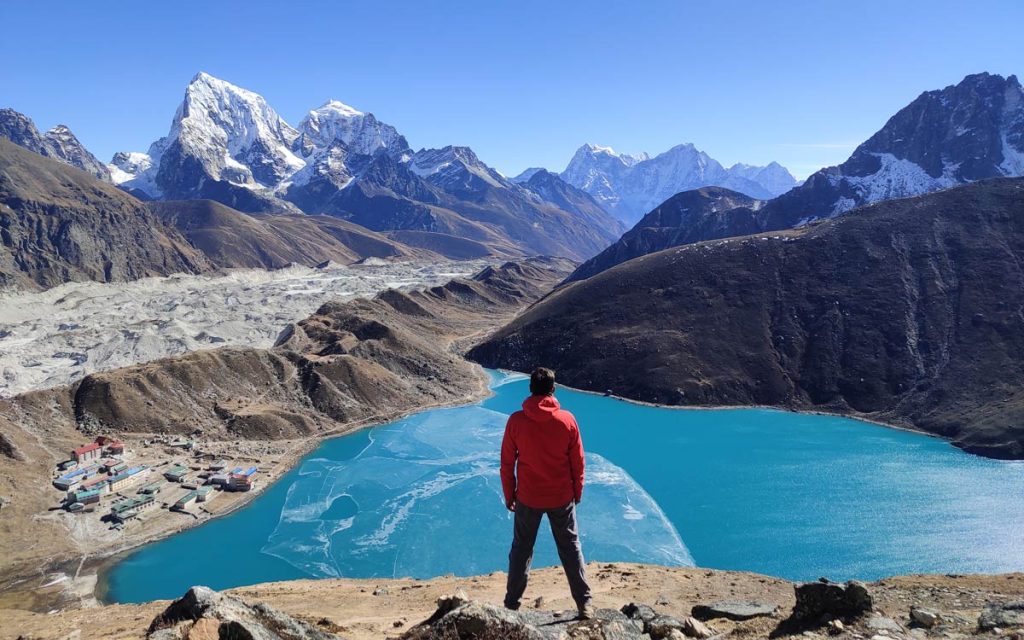
Gokyo to Everest Base Camp trek offers a thrilling variation to the classical route, making it one of the most challenging treks in the Everest Region. It is the rewarded trek for all the hikers and trekkers seeking an adrenaline rush.
In addition, you’ll be walking through the world’s highest and Nepal’s largest Glacier, the Khumbu Glacier.
The journey from the pristine Gokyo lake, through the challenging Cho-La pass, and towards Everest Base Camp, is a must-embark journey for every trekker.
Additionally, the trails of this trek provide you with a different path than the usual trail, ensuring that you won’t be retracing your steps while Trekking in Nepal.
4. Annapurna Base Camp Trekking
| Max.Altitude: | 4,130 m/13,550 ft. |
| Trek Duration: | 13 days |
| Difficulty Level: | Strenuous |
| Best Months: | Feb, Mar, Apr, May, Mid-Sep, Oct, Nov, and until Mid-Dec |
| Trek Permits: | Annapurna Conservation Area (ACAP), TIMS |
| Accommodation Type: | Teahouse |
Highlights:
- Immerse in the varied flora and fauna of the Annapurna Region
- Witness the remarkable view of the world’s 7th and 8th highest mountains; Dhaulagiri and Annapurna I
- Summon in the beautiful sunrise view from Poon Hill
- Accommodate in the laps of the Himalayas; Annapurna Base Camp
- Rejuvenate in the refreshing hot spring at Jhinu Danda
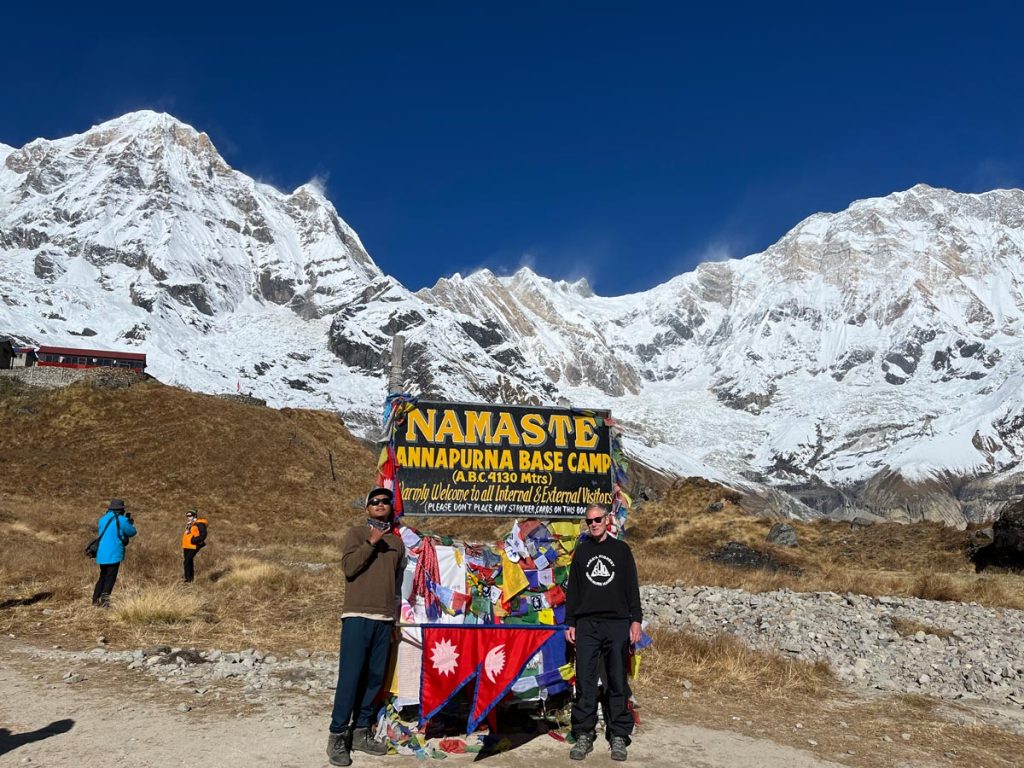
Annapurna base camp is the best-preferred trek of Nepal for mountain lovers seeking an unforgettable experience.
Spending a night at the base camp, surrounded by the majestic Himalayas, makes all the hard climb worth it.
The trek begins from the tourism hub; Pokhara, offering a range of hiking and trekking options, from short hikes to challenging high-altitude treks in the Annapurna region.
Perhaps, this trek offers breathtaking views of the Annapurna mountain range, a rich cultural experience, and a chance to immerse oneself in the natural beauty of trekking in Nepal’s Himalayas.
5. Annapurna Circuit Trek in Nepal
| Max.Altitude: | 5,416 m/17,769 ft. |
| Trek Duration: | 19 days |
| Difficulty Level: | Strenuous |
| Best Months: | Feb, Mar, Apr, May, Sep, Oct, Nov, and Dec |
| Trek Permits: | Annapurna Conservation Area (ACAP), TIMS |
| Accommodation Type: | Teahouse |
Highlights:
- Scenic Mountain long drive from Kathmandu to Syange
- Ascend along the enthralling Marshyangdi River Valley
- Behold the captivating vistas, and conquer Thorong La Pass at 5,416 m
- Find spiritual solace in the Pilgrimage town of Muktinath
- Marvel at the magnificent sunrise views from Poon Hill
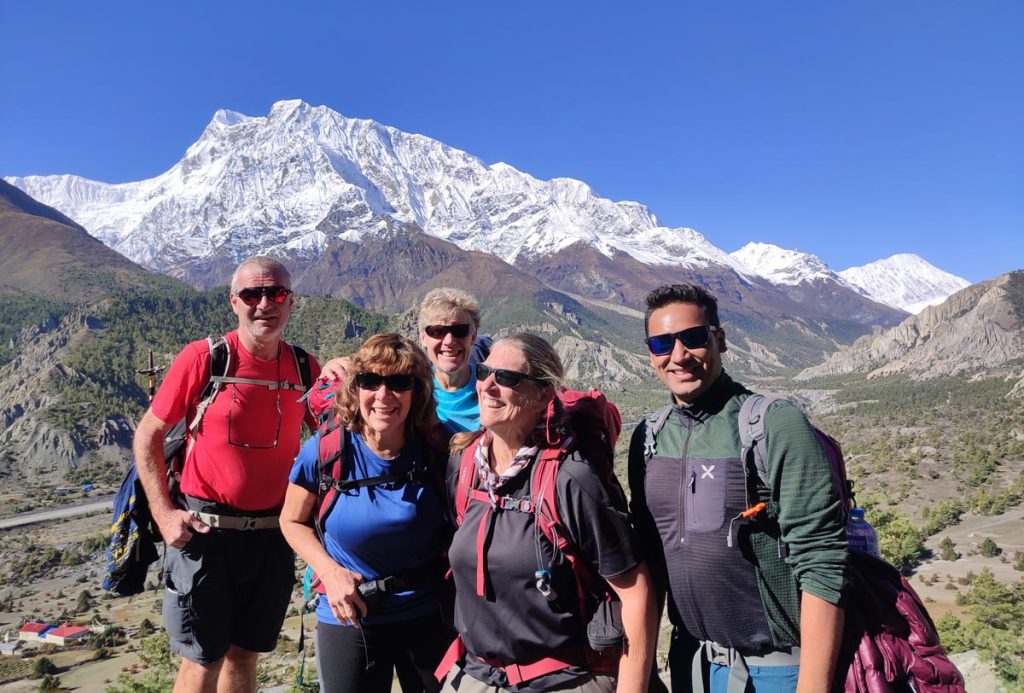
Annapurna Circuit trek is a popular and diverse destination for trekking in Nepal offering a wide range of experiences for adventure seekers while trekking in Nepal in the heart of the Himalayas.
This takes you through some of the most spectacular mountain views in the world, including the Annapurna Massif and Dhaulagiri, and takes you to the Thorong La Pass, which offers incredible panoramic views.
Moreover, the trek is also suitable for the ones who are into culture and traditions as well. The trek offers a rich cultural experience as it takes you through the traditional villages of Gurung,
Thakali, and Manangi communities where you can learn about their unique culture, traditions, and lifestyles. Hence, it is an excellent choice for those seeking a challenging and diverse trekking experience.
6. Ghorepani Poonhill Trekking in Nepal
| Max.Altitude: | 3,210 m/10,531 ft. |
| Trek Duration: | 9 days |
| Difficulty Level: | Moderate |
| Best Months: | Feb, Mar, Apr, May, Sep, Oct, Nov, and Dec |
| Trek Permits: | Annapurna Conservation Area (ACAP), TIMS |
| Accommodation Type: | Teahouse |
Highlights:
- Experience the beauty of Nepal’s natural landscape through the drive to Pokhara
- Witness the breathtaking sunrise over the Himalayas from Poon Hill
- Immerse yourself in the fascinating traditions in Ghandruk village
- Enjoy the vibrant hues of the colorful rhododendron forests
- Savor the flavors of Nepal’s delicious cuisine
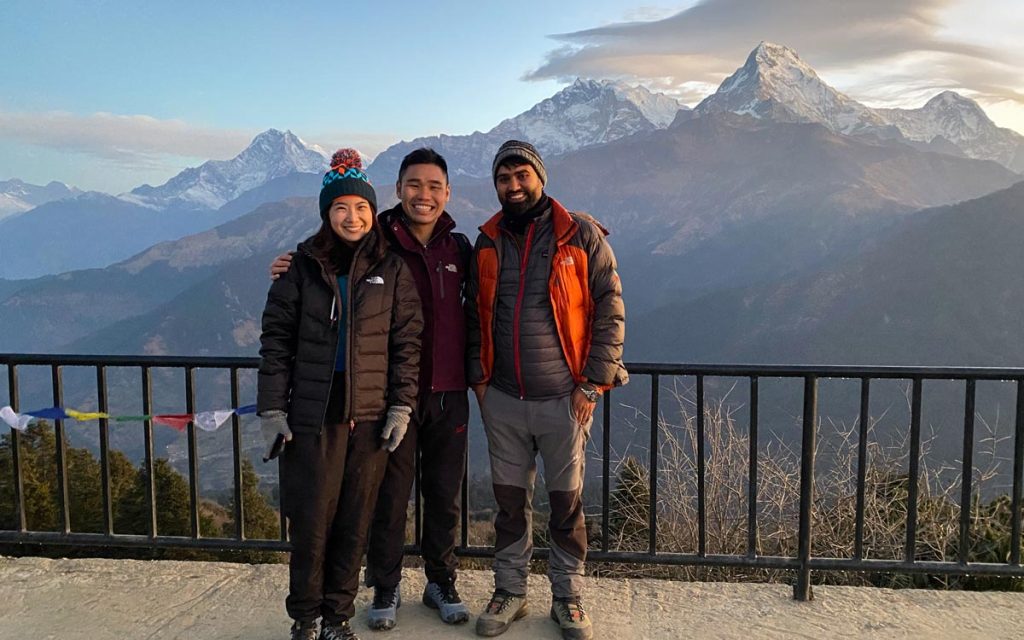
Ghorepani Poon Hill trek is the hidden gem in the majestic Annapurna region that is waiting to be discovered.
This mesmerizing trek takes you on a journey through picturesque landscapes, charming villages, and breathtaking vistas that are sure to leave you enchanted.
Walking through the lush forests of rhododendron and oak, you’ll witness the vibrant colors of Nepal’s flora and fauna, and be serenaded by the sweet songs of exotic birds.
Besides that, the true highlight of the trek is the climb to Poon Hill, where you’ll witness the most magnificent sunrise you’ve ever seen.
As the sun paints the sky with red, orange, and pink hues, the snow-capped peaks of Annapurna, Dhaulagiri, and Machhapuchhre stand tall in all their glory, offering a sight that will take your breath away.
It is one of the best short treks of Nepal as you’ll experience the charm of rural Nepalese life and get a taste of authentic Nepalese cuisine.
7. Upper Mustang Trek
| Max.Altitude: | 4,135 m/13,563 ft. |
| Trek Duration: | 16 days |
| Difficulty Level: | Strenuous |
| Best Months: | Feb, Mar, Apr, May, Jun, Sep, Oct, and Nov |
| Trek Permits: | Annapurna Conservation Area (ACAP), TIMS |
| Accommodation Type: | Teahouse |
Highlights:
- Explore hidden kingdom in Trans-Himalayan land
- Tour the manmade sky cave & picturesque Himalayan view
- Visit monasteries: Ghar, Thokten, Choten, Luri Gompa, etc.
- Hike desolate trails of “Pa-Pass” in Upper Mustang
- Discover life in the mountains; visit Muktinath, a holy temple
Upper Mustang is a mesmerizing and mystical land, tucked away in the heart of the Trans-Himalayan region of Nepal. This hidden Kingdom is a dreamland that beckons you to explore its unique and stunning landscapes, culture, and traditions.
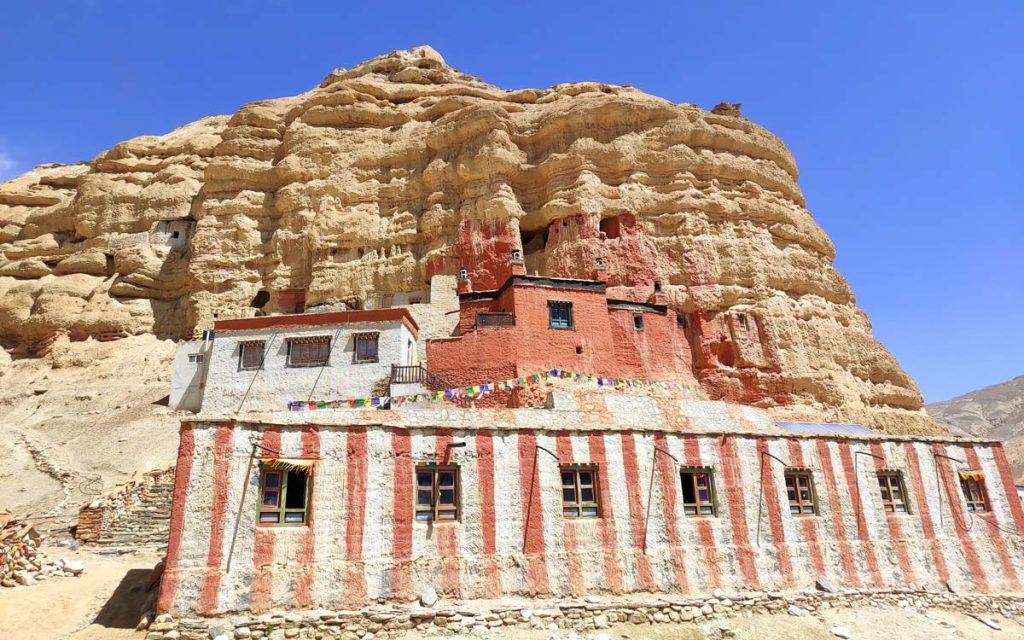
Imagine hiking across desolate trails, surrounded by rugged mountains, ancient caves, and mystical monasteries.
As you explore the hidden gems of Upper Mustang, you’ll discover the secrets of the ancient Kingdom, which was once forbidden to outsiders.
The region’s walled city of Lo Manthang, with its whitewashed building and stunning architecture, is a sight to behold. The city’s narrow alleys and winding streets will transport you to another era, where time seems to stand still.
One of the most alluring features of Upper Mustang is the Luri-Gumba, a magnificent monastery perched on a 100 m high cliff of sharp rock. The unique art and architecture of this ancient temple are a testament to the ingenuity and creativity of the Mustang people.
But that’s not all; Upper Mustang has much more to offer. You can visit Muktinath, the holiest temple in both Hinduism and Buddhism or hike across the desolate trails of “Pa-Pass,” which is a challenge that is not for the faint of heart.
8. Nar Phu Valley Trek with Annapurna Circuit
| Max.Altitude: | 5,416 m/17,769 ft. |
| Trek Duration: | 18 days |
| Difficulty Level: | Strenuous |
| Best Months: | Feb, Mar, Apr, May, Sep, Oct, Nov, and Dec |
| Trek Permits: | Annapurna Conservation Area (ACAP), TIMS |
| Accommodation Type: | Teahouse |
Highlights:
- Find peace in the tranquil Kali Gandaki River valley
- Explore the enchanting villages of Nar and Phu
- Experience vibrant monasteries along the trekking trail
- Conquer the legendary Kangla and Thorong la Passes
- Visit the sacred and stunning Muktinath temple
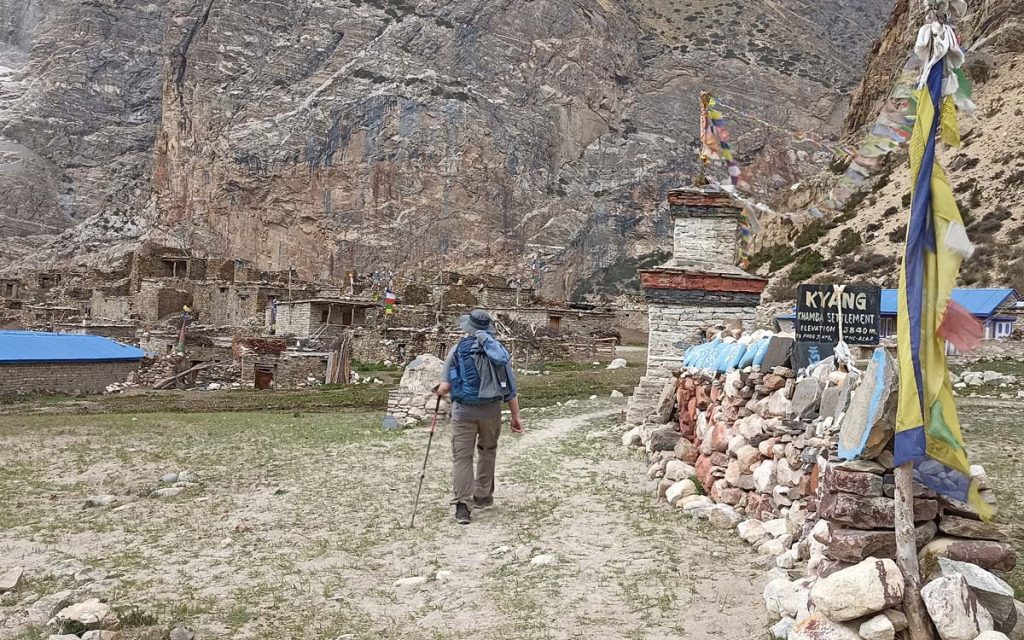
Nestled in the heart of the magnificent Annapurna region, Nar Phu Valley and Annapurna Circuit trek are the two most breathtaking treks in Nepal, each with its own unique charm and appeal.
The Nar Phu valley trek takes you off the beaten path in Nepal to discover the rich culture and unique lifestyle of locals who continue to live a nomadic life, herding yaks and sheep across the rugged terrain.
Annapurna Circuit trek on the other hand takes you through the diverse landscapes, from verdant forests to arid deserts, snowy mountains to quaint villages.
Additionally, it traverses into famous passes like Kangla and Thorong La for unparalleled views of the majestic Himalayas.
Both of these treks are done together to experience the best of both worlds. You’ll experience the serenity of Kali Gandaki River valley, ancient caves, stunning waterfalls, rugged mountains, and many more.
9. Manaslu Circuit Trek in Nepal
| Max.Altitude: | 5,215 m/17,105 ft. |
| Trek Duration: | 15 days |
| Difficulty Level: | Strenuous |
| Best Months: | Mar, Apr, May, Sep, Oct, and Nov |
| Trek Permits: | Manaslu Conservation Area, Annapurna Conservation Area, TIMS |
| Accommodation Type: | Teahouse |
Highlights:
- Breathtaking drive from Kathmandu to Manchha Khola
- Immerse in the tranquil beauty of Budhi Gandaki River valley
- Experience the unique blend of Nepalese and Tibetan cultures
- Walk along the border between Nepal and Tibet
- Conquer the Larkya La Pass, standing tall at 5,125 m
The Manaslu circuit trek is a hidden gem in Nepal that takes you on a journey through remote villages, lush forests, and stunning mountain landscapes. It is one of the most thrilling and adventurous treks in Nepal.
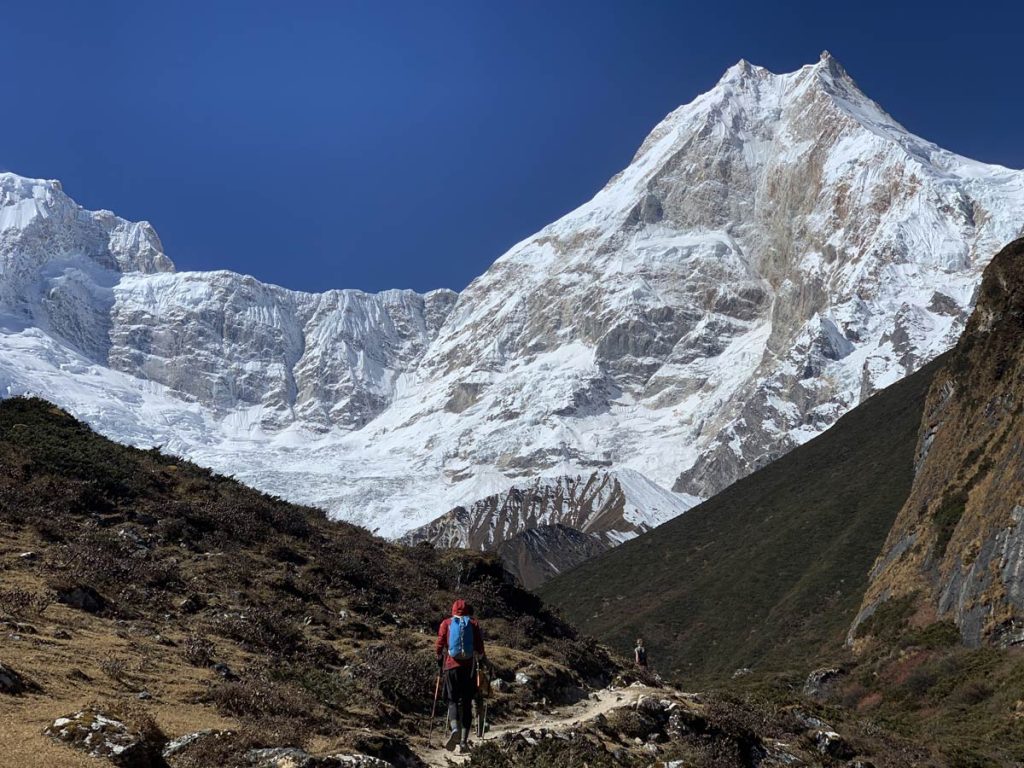
As you trek around the eight highest peaks in the world, you’ll witness the unique blend of Nepalese and Tibetan culture and experience the warm hospitality of the locals.
The trail follows the Budhi Gandaki River and passes through dense forests, beautiful waterfalls, and picturesque villages.
The highlight of the trek is the challenging Larkya La pass, standing tall at an altitude of 5,215 m. This challenging yet rewarding trek offers an off-the-beaten-path adventure that is perfect for nature lovers and trekking enthusiasts alike.
It is a unique opportunity to interact with the friendly locals and experience their daily life. The villages you pass through on the trek are remote and untouched by modernization which adds to the charm of the trek.
10. Langtang Valley Trek
| Max.Altitude: | 4,984 m/16,351 ft. |
| Trek Duration: | 10 days |
| Difficulty Level: | Demanding |
| Best Months: | Jan, Feb, Mar, Apr, May, Jun, Sep, Oct, Nov, and Dec |
| Trek Permits: | Langtang National Park, TIMS |
| Accommodation Type: | Teahouse |
Highlights:
- Views of snow-capped peaks such as Langtang Lirung, Dorje Lakpa, and Ganesh Himal
- Visit the traditional villages of Langtang, Kyanjin Gompa, and others
- Experience alpine landscapes and high-altitude lakes such as Gosainkunda
- Learn about the region’s history and culture at the local museum and visit the yak cheese factory
- Panoramic view of the Langtang range from Tserko Ri
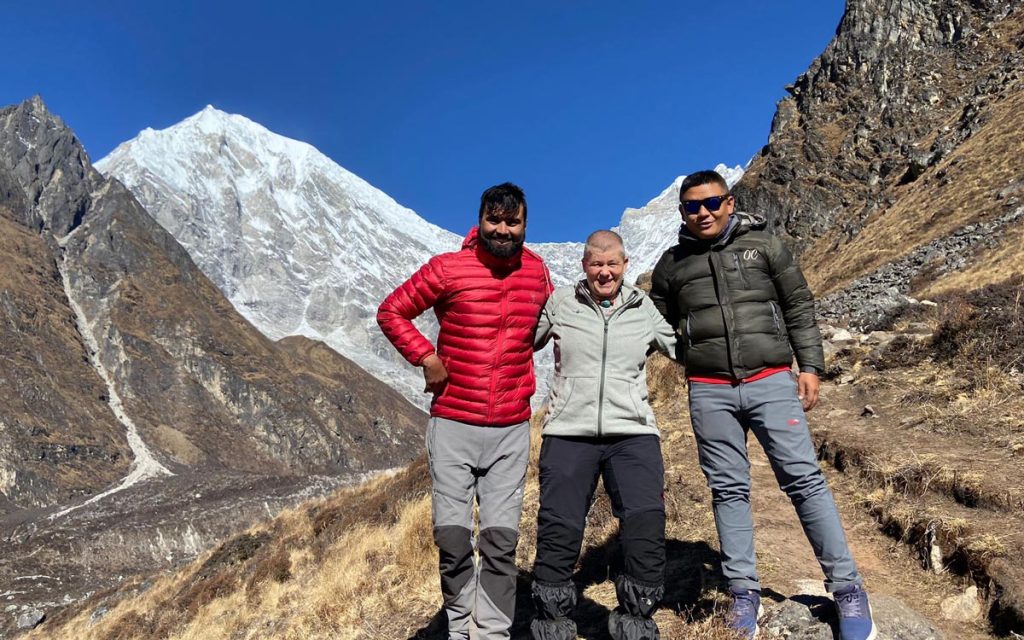
The Langtang Valley trek is a popular “trekking in Nepal” that takes you to the Langtang National park, which is home to diverse flora and fauna, lush forests, glistening glaciers, and snow-capped peaks.
It is a great opportunity to experience the warmth and hospitality of the Tamang community. You can visit the traditional Tamang villages such as Langtang and Kyanji Gompa and experience their music and dance performances.
Additionally, the highlight of the trek is the Tserko Ri peak, which offers a breathtaking panoramic view of the Langtang range.
Tserko Ri is challenging but worth the effort as you can witness spectacular sunrises and sunsets from this vantage point. Hence, it is an excellent opportunity to disconnect from technology and immerse yourself in nature.
In conclusion, Nepal is home to some of the most breathtaking trekking routes in the world. The country’s stunning natural beauty, diverse landscapes, and rich cultural heritage make it an ideal destination for trekkers of all levels.
From the world-famous Everest Base camp trek to the less crowded but equally stunning Langtang Valley trek, trekking in Nepal has something for everyone.
Best Nepal trekking tips for beginners
Trekking in Nepal is undoubtedly the most magical experience for any trekker, but as a beginner there are several aspects you need to be mindful of.
As exciting as treks can be, they are also arduous and uncertain in their ways, for someone who isn’t used to these experiences, the idea of immediately leaping into one of the most popular destinations for treks as a beginner can certainly be a little spooky.
The following tips will help ease your nerves and assist you through a wonderful trek:
Choose the right trek
As a beginner it is important to choose the right trek for yourself, as someone with little experience and knowledge it is advised to go for treks that don’t require much strain and dispute.
You should be aware of what your body and mind is capable of, this will make it easier for you to narrow down your options and decide on treks that might be best fitting for you.
According to the level of difficulty treks are divided into several grades, as a beginner it is always wise to choose treks that are easy and moderate in those terms.
Acclimatize
Acclimatization is essential during high altitude treks. One of the biggest issues with trekking at a high altitude is altitude sickness. As a beginner if you are making trips in high elevations, acclimatization is a must.
While trekking remember to frequently rest if required and gradually pace up. There will be several chances for acclimatization at rest stops, this will help you get used to the altitude and minimize risks.
Go with a guide
A guide is always an advantageous addition to your trekking trip.
With a local guide you will be able to gain valuable insights not just into the geography and the natural environment of the region but also the culture and practices of local people.
When it comes to emergencies and accidents difficult to recover, a guide will be your savior.
With someone who can professionally plan, organize and assist you on your trek, you will be able to have a wonderful time free from distractions.
Pack light and prioritize essentials
When it comes to treks, it is always advised to pack light. Do not carry unnecessary loads on your backpack, only carry the essentials.
Remember to pack warm clothing, your trekking boots, trekking gear, toiletries, and other miscellaneous items you might absolutely need.
Carry a first aid kit
Although having a first aid kit could increase the weight on your backpack and take up some space, it is not unnecessary baggage.
Having a first aid kit on you will be totally handy if you happen to get some minor injuries or even major accidents along the trail.
Eat well and hydrate
With all the physical strain you put on yourself throughout the trek, it is extremely important to gain back the lost energy through food and water.
The Nepali cuisine is not just delicious but also extremely nutritious, it will help fuel your body and strengthen your mind.
It is also necessary to stay hydrated during the trek so make sure to pack a hefty water bottle for yourself.
Tea Houses and Lodging
Across many popular trails in Nepal, you will find various tea houses and lodges established to accommodate trekkers through their hike.
Offering a unique blend of local hospitality and basic amenities, tea houses are unique to Nepal’s trekking culture.
Respect the people and culture
Be mindful of the local culture and traditions, be observative and avoid offending the locals.
Nepali people are known for their unique culture and traditions, most of their beliefs and practices could be totally foreign to you but respecting their stance will bring you closer to the people and stay connected.
What to pack for trekking in Nepal?
Packing is extremely important during treks. Unlike usual trips when packing for a trek, you have an awfully limited space and several essentials to carry.
Being mindful of the things you might need and not unnecessarily overpack is the key to having the perfect trek backpack.
When all your essentials are packed well, you will be able to enjoy a smooth and efficient trek.
The items you will need to pack are listed as follows:
Clothing
- Thermal underwear
- Fleece or down jackets
- Waterproof jacket and pants
- Trekking pants (lightweight, quick drying) and shorts
- Long sleeved shirts
- T-shirts (lightweight, breathable)
- Heavy weight pants and jacket for higher elevations
- Underwear and socks
- Winter hat and gloves
- Summer hats
- Woolen socks
- Buff or neck gaiter
Footwear
- Sturdy trekking boots
- Camp shoes (sandals, sneakers)
Trekking Equipment
- Backpack (size depends on whether you have porters or not)
- Sleeping bag
- Trekking poles
- Head lamp and extra batteries
- Sunglasses with UV protection
- Water bottles
- First aid kit
- Camera and essential electronics
- Extra zip log bags
Personal items
- Passport and Permits
- Sunscreen
- Moisturizer
- Toiletries (Toothbrush, Hand Sanitizer, Toothpaste, Toilet paper)
- Lip balm
- Insect repellent
- Personal hygiene items (Sanitary Napkins)
- Prescribed medication
- Snacks, instant food
Miscellaneous
- Duct Tape
- Waterproof backpack covers
- Trash bags
Packing Tips
- Choose a comfortable backpack, one that is spacious and easy for you to carry.
- Prioritize your essentials (clothes, shoes, passport and documents, and trekking equipment)
- Test your trekking gear before packing
- Keep your electronics and important documents in waterproof bags safely
- Be mindful of the weight, keep your backpack light
- Check the weather conditions and pack accordingly
Buying equipment in Nepal
As a popular destination for trekking and mountaineering Nepal offers a good range of trekking equipment and gears for rent as well as for sale.
You can buy all the required trekking equipment from either Kathmandu or Pokhara. The cities have several retailers that primarily focus on trekking gears, comparing the prices and quality before purchase is essential.
When you’re buying your equipment make sure to keep the altitude of your trek in mind, according to what gears might be needed or might not be, purchase wisely.
Frequently asked questions about trekking in Nepal
What is the best month to trek in Nepal?
The ideal months for trekking in Nepal extend from March and April in spring to September through November in Autumn.
Spring days are longer and warmer, while bustling trails and the colorful scenery enhances the trekking experience. Autumn is dry and the temperature is moderate, ensuring clear skies and marvelous views.
How much does it cost to go trekking in Nepal?
The cost of trekking in Nepal can differ according to the type of trek you want to go on, the region you want to trek, the duration of your trek, the services and the level of comfort or luxury you seek.
For trekking through trails that require a permit you will need to pay depending on the area, different regions have different permit fees.
Guides and porters charge could also differ according to the region and duration. Food and accommodation costs for basic meals and teahouses are lower in comparison to comfortable lodges with attached bathrooms and better amenities.
The cost throughout your trek could also largely vary in terms of the season and demand trend, it is never quite fixed.
What are the safety considerations for Hiking in Nepal?
Prioritizing safety is of great importance, particularly when engaging in outdoor activities. Hiking in Nepal presents a wonderful opportunity to discover the country’s stunning landscapes and immerse oneself in its rich culture but to fully enjoy this experience, it is crucial to ensure your safety.
Here are some essential safety tips to keep in mind when hiking in Nepal:
Physical fitness
Before the trek make sure to check and confirm whether you’re fit enough to handle it. Regular exercise and warmups can help you prepare for longer walks at higher altitudes.
First aid Kit
Having a first aid kit on you is extremely crucial during hikes. Make sure to include pain relief and altitude sickness medications in your kit, and don’t forget medications personally prescribed to you.
Learning when and how to use certain medications and a basic understanding of how first aid operations work will definitely be worth it.
Hydration and Nutrition
Through long, demanding hikes it is extremely essential to hydrate well and eat when you can. Having some snacks on you will also help keep your energy and spirits up.
Weather considerations
Be aware of weather conditions in Nepal that can vary largely depending on the season. For your safety avoid treks when the weather is particularly harsh or unstable.
Guides and permits
Hiring local guides will help you through most of your hurdles when hiking in Nepal. They don’t just provide you with insightful knowledge but handle emergencies, minimize risks, and help you settle through trails and localities.
Obtaining all necessary permits is also made easier through connections with the local travel agency. To ensure security through your travels, this is very important.
Communication
Do not forget to carry your mobile phone, fully charged with a portable charger, along with you always.
In case of riskier expeditions, it is nice to have alternative communication devices like satellite phones to help during emergency situations.
How to train for trekking in Nepal?
Certain treks in Nepal can be challenging and often formidable. To persevere through trails and not lose purpose, proper training is crucial.
First off, it is important to assess your fitness level, being aware of your strength, endurance, flexibility and overall health is extremely important before you begin training accordingly.
Tailor your workout plan to align well with the intensity of your trek, ideally initiating training about 2-3 months prior. This will help you get used to the demanding mobility and boost your stamina.
Going on regular hikes, especially ones at an impressive altitude, will help familiarize you to both the elevation and the intricacies of the trails.
How difficult is trekking in Nepal?
Trekking in Nepal can significantly vary in difficulty according to the region you choose to trek to. The country offers an impressive variety of treks from easy short-term treks to challenging long-term expeditions.
Treks high in altitude with steep, rocky terrains, longer durations and unpredictable weather conditions can be quite difficult to navigate.
How to choose the right trekking agency for your Nepal adventure?
Choosing the right trekking agency makes all the difference through your travel experience. It is important to research and put your time into searching for agencies that compliment your trekking plans.
Carefully verify and confirm the agency registration and license along with the certification of their guides. Read reviews and testimonials from people who have trekked with the agency before and look for a positive pattern.
Compare prices, services and the itinerary to finally decide on what agency could be the best for you.
What are the permit requirements for trekking in Nepal
Trekking permits provisioned to protect the cultural and natural resources of the country are essential to secure the peace of its environment and to ensure safety.
Depending on the region you are trekking to there are various types of permits you will need to have to proceed. Different rates will be applicable for different routes and regions.
Tour operators can apply for permits on the trekkers’ behalf by contacting the department of immigration where all the necessary formalities will be taken care of.
The following are major permit requirements for trekking in Nepal:
TIMS card
TIMS (Trekking information management system) card is required for all trekkers through most trekking regions of Nepal.
It is a management system that ensures the safety of trekkers and helps regulate the trekking operations in the country.
The TIMS card is not available for FIT’s but only group trekkers with a licensed guide. To purchase a TIMS card, trekking agencies are to register with information of trekkers, guides and trekking routes.
Restricted Area Permit
To enter the restricted areas in Nepal like the Upper Mustang area, Tsum Valley, and Upper Dolpo, you will need special restricted area permits.
These permits can be obtained from the Department of Immigration through an authorized tour operator.
National Park or Conservation Area Permit
If you’re planning to enter any National Park or Conservation Area in Nepal, you will need specific permits for every park or area.
The Annapurna Conservation area needs you to obtain the Annapurna Conservation Area Permit (ACAP). Likewise, to enter the Sagarmatha National Park you will also need a Sagarmatha National Park entry permit.
You can issue these permits at the Department of National Parks and Wildlife conservation in Kathmandu, the Tourist Service Center also in Kathmandu or any of the entry points.
Do you need to hire a trekking guide?
There is a lot you could gain from having a certified professional guide you through trails and terrains foreign to yourself.
Trekking guides ensure your safety, provide you with knowledge on the diverse ecosystem you could encounter, and help you acquaint yourself with the local people, their culture and traditions.
Guides also help navigate through complex trails, mishaps and accidents that could occur during the trek.
What is the availability of phone and internet services at higher altitudes during treks in Nepal like?
Phone and internet services at higher altitudes during treks in Nepal can be limited but still present.
When it comes to remote, less known trekking regions there is low to almost no coverage at all but with popular destinations you can find decent network coverage.
Many well-traveled trails offer exclusive Wi-Fi services that are dependable and affordable. You can purchase Wi-Fi through lodges and tea houses along your route too.
However, it is important to note that elevation and weather conditions also have much to do with how strong your signal is so although phone and internet services are available, they cannot always be relied on.
